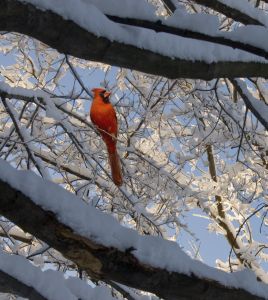
The air is cold and crisp, but not too crisp. It’s sunny out, and it’s perfect weather for birding. Before we go back to our usual deluge, we’ve been able to spot a lot of birds who cluster around our backyard feeder. We’re intermittent bird feeders in the summer, but winter birds can usually depend on us. My daughter and I love to watch them, especially after the first snowfall comes and the birds leave tiny footprints on the snow.
Some of the birds in our area migrate to warmer places for the winter, while others move down from the mountains into somewhat warmer areas like our backyard. With a pair of binoculars and a good bird book that features drawings of local birds, you too can encourage your budding bird watcher.
Now, you might know nothing about birds. Sure, they fly, right? But that’s the extent of your knowledge. Here are a few pointers to help you and your child discover the joy of birds and perhaps even identify a few:
* What is the bird doing in your yard? Is it roosting? This means it is fluffing up its feathers and sitting on a branch. Is it preening? This means it is cleaning its feathers. Perhaps the bird is hopping around and looking for food.
* How does the bird move around the yard? Is it a hopper? Does it soar high above? Does it sit quietly in a branch, waiting for its prey or hoping not to be noticed? Does it swirl around the tree looking for bugs?
* Take a look at the bird’s beak through a pair of binoculars. What does it look like? Is it long and thin? Hummingbirds have long, thin beaks, perfect for collecting nectar. So do woodpeckers, because their beaks are built for drilling holes. Birds with shorter, squatter beaks tend to be seed-eaters.
* Does the bird make any sounds? Winter is not the ideal time to hear birds, since they do a lot of singing in the spring. However, any time they are scared you have a chance to hear their alarm call.
* What does the bird look like? How large is it, and what color are its feathers? This information and the information about its beak will help you figure out what the bird might be.
I recommend a good, local bird book with pictures, not photos. The pictures will give you a good representation of the average bird of that species. Choose a local book so that you’re not stuck leafing through thousands of bird species. It’s not about the identification so much as it is about enjoying the hunt and the discovery.
Enjoy your time exploring the world of winter birds with your preschooler!

